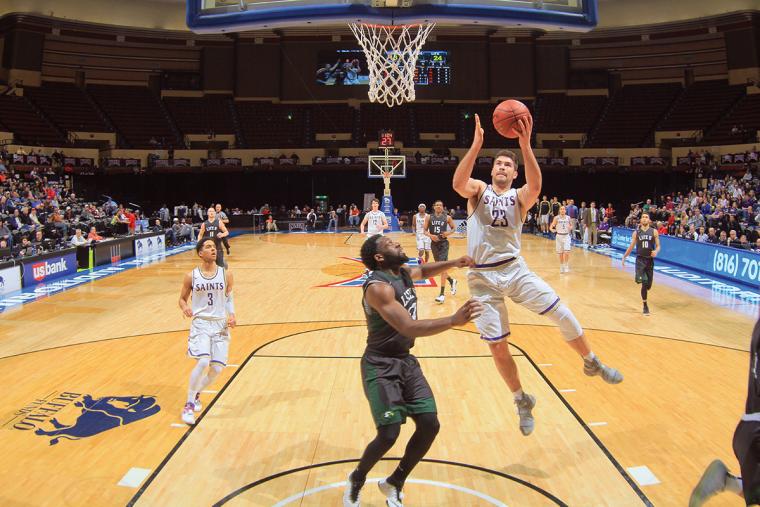

The NAIA now oversees 25 national championships in sports including football, soccer, cross country, swimming and diving, competitive cheer and dance, golf, tennis, lacrosse and others including, yes, basketball – which is now played in two divisions. As the organization has grown in size and sophistication, so have NAIA’s offerings to its member institutions. This includes not only increasing and diversifying the number of championship events, but increasing and diversifying the ways to bring those events to students and others. Live streaming has become an excellent and cost-effective way to do this, and one of NAIA’s strongest aspects of its programming.
Beginning a little over a decade ago, NAIA offered live streaming of only a handful of events. As streaming became more popular and more accessible, and as awareness of it grew, NAIA began increasing its offerings and now streams a total of 21 out of its 25 championships; action from the remaining four sports can be seen in a video highlights package.
For those who are currently investigating live streaming, here are some lessons from real life, using NAIA as a case study:

Why do you want to live stream? Who is your desired audience? And realistically, who is it that you expect to be watching your events? Maybe you’re thinking of other athletes who make up a fan base or people who are passionate about the sport but aren’t able to be at important events or championships. Maybe you’re thinking of families at home who want to watch someone compete. Maybe you want to set up a mechanism for coaches, athletic directors or scouts for other organizations to be able to watch up-and-coming athletes.
NAIA’s assumptions are that a majority of people watching are, in one way or another, connected with the schools themselves. Maybe they’re students, alumni or parents and friends of students, and they can’t be at the championship game but they want to see it. Maybe they work with a school’s athletic department or elsewhere in the school and want to see what is happening. There may be other reasons people tune in to watch other sports, but this is what NAIA views as its target audience.
Identify Your Needs
Once you’ve identified your audience (or once you have a general idea of who those people will be), it’s time to decide what you want to do for them with live streaming. What kind of a fan experience do you want those viewers to have? Are you trying to create a very fan-friendly package with a lot of options for viewing the action and interacting with it (which may cost more) or do you want something that is more stripped-down and simple? Maybe you’re trying to use this as a possible revenue stream. In that case, you may want to look into offering more features to make it fun enough or useful enough for the viewer to come back and watch another event.
It’s not uncommon for an organization to work with a vendor of live streaming services, and in many cases, it is preferable to do so. NAIA works with one such company, Stretch Internet, which provides a range of services to the organization. This has allowed NAIA to create what has become a very first-in-class, fan-focused, high-definition streaming experience, with everything from instant highlights and different camera angles, to interactive social media display and live stats and scores displayed on a split screen. The vendor has also been able to create a tiered pricing system, which corresponds to the number of events and days the viewer is interested in consuming. The goal of this was to create both an affordable system for the viewer and an excellent fan experience, while still allowing NAIA to monetize the service.
In investigating any vendor, find out about its experience with recording and streaming sports. Learn what features are available to customers, and whether there is room to grow, should your needs change. Discuss your goals and your target audience as well as the types of events you expect to be streaming and their locations. In addition to checking references, look at any prospective vendor’s work. Then picture your target audience and think about whether they will find this vendor’s services interesting, useful and compelling.

The number of NAIA’s championship games, and the varying locations for them, creates some unique challenges when it comes to streaming. As such, NAIA has developed minimum standards for sports facilities, including those relating to Internet connectivity, when it comes to deciding on host locations for championship games.
Once a city and facility is identified, NAIA will work with the local school and sports commission/CVB in the area, and will find out if that institution has a video production company they work with. The host city’s convention and visitors bureau or sports commission may also have information about vendor companies in their area, and can be a resource. In addition, NAIA has working relationships with national vendors who can outsource recording to regional companies; this is another very cost-efficient way of securing quality services.
Benefits of Streaming
Live streaming sports events has a number of benefits, outside of being a possible source of income, when done correctly. The NAIA has seen that streaming can aid in recruitment and retention for the college, can serve as an overall branding piece for the various conferences, and can help create a stronger identity for the national body. After all, most schools don’t have an ESPN network with television contracts, so this serves as a way to broadcast the events that are important to the organization.
Some of the most impressive viewership numbers have come from NAIA’s six-day basketball events, which brought in up to 25,000 views. (Typical events might have a baseline of about 5,000 to 7,000 people watching.)
The NAIA tracks its viewership, but has also noticed these number can be affected by factors outside of its control. For example, the recent Division II Women’s Volleyball Championship in Sioux City, Iowa, included participation from quite a number of local teams – schools from Iowa, South Dakota and North Dakota, to name a few, which negatively impacted the number of people who chose to watch online. (The next big event, the 2018 DII Women’s Basketball Championship in March, also will be held in Sioux City, and NAIA will be watching those numbers as well.)
Marketing Streaming Services
NAIA, as a national organization, relies upon its conferences and member institutions to help market its streaming services. Students and alumni of colleges involved in a specific sports event, for example, would be the viewers these organizations could target in e-mails and other notifications.
The Evolution of a Market
Live streaming continues to evolve and change, and for that reason, it is essential to find partners who are willing to grow along with any streaming program. NAIA selected Stretch Internet, for example, because it is an innovative company with experience in the collegiate streaming environment. Equally important to growth is the ability to listen to fans, and to find out what they want from their streaming experience. Video technology will continue to be in demand, and it will be essential to stay on top of any trends and changes in order to remain relevant. SDM

